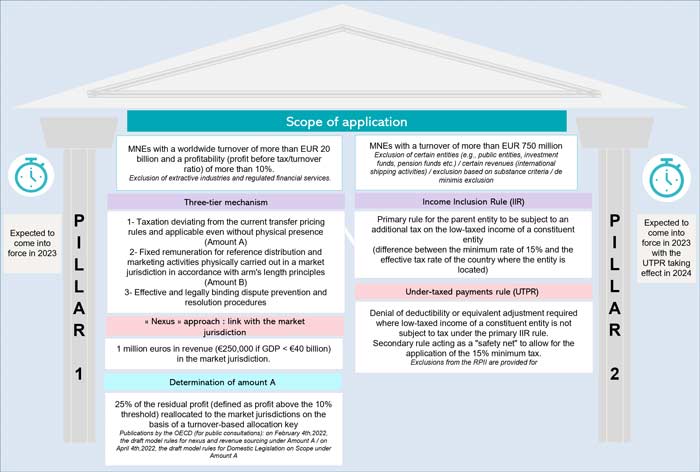-
Tax Policy Management
Tax Policy Management
-
Growth Management
Growth Management
-
Tax audit and litigation
Tax audit and litigation

-
Definition of a strategic and secure transfer pricing structure
Definition of a strategic and secure transfer pricing structure
-
Assistance in the development of international activities and operational reorganisations – “Business restructuring”
Assistance in the development of international activities and operational reorganisations – “Business restructuring”
-
Defense of practices and assistance in the context of tax audits and their follow-up from a litigation viewpoint
Defense of practices and assistance in the context of tax audits and their follow-up from a litigation viewpoint
-
Annual declaration and documentation obligations
Annual declaration and documentation obligations

-
Domestic and international VAT applicable to your company's flow
Domestic and international VAT applicable to your company's flow
-
Banking and financial VAT, VAT in the insurance sector
Banking and financial VAT, VAT in the insurance sector
-
VAT related to real estate registration fees
VAT related to real estate registration fees
-
VAT in the public and non-profit / association sector
VAT in the public and non-profit / association sector
-
Tax audit, tax litigation and relations with the Tax authorities
Tax audit, tax litigation and relations with the Tax authorities
-
Applicable rules for invoicing
Applicable rules for invoicing
-
Customs issues related to your company's international flows
Customs issues related to your company's international flows
-
French VAT registration and compliance obligations
French VAT registration and compliance obligations
-
Payroll tax
Payroll tax
-
Other indirect taxation
Other indirect taxation

-
Company transfer diagnosis
Company transfer diagnosis

-
Distribution strategy : Implementing and structuring
Distribution strategy : Implementing and structuring
-
Distribution activities digitalisation
Distribution activities digitalisation
-
Relations between suppliers and distributors
Relations between suppliers and distributors
-
Contractual policy : etablishing and structuring
Contractual policy : etablishing and structuring
-
Controls and litigation regarding payment terms
Controls and litigation regarding payment terms
-
Organising and securing commercial relations with consumers
Organising and securing commercial relations with consumers
-
Data protection - GDPR
Data protection - GDPR
-
Commercial Leases
Support in the management and contract management of commercial leases.

-
Traditional Services offered
Traditional Services offered
-
Health at work and quality of life at work
Health at work and quality of life at work
-
HR Management Audit
HR Management Audit
-
HR Engineering and People Change
Implementing managerial solutions in line with the company's strategic challenges
-
Management of HR compliance and internal investigations (harassment, discrimination, and whistleblowing)
Management of HR compliance and internal investigations (harassment, discrimination, and whistleblowing)

-
Advice on legal structuring
Advice on legal structuring
-
Day to day company management
Day to day company management
-
Companies reorganisation
Companies reorganisation
-
Mergers & Acquisitions - Private Equity
Mergers & Acquisitions - Private Equity
-
Changes in shareholder structure - Securities issue
Changes in shareholder structure - Securities issue
-
Governance and legal risks management
Governance and legal risks management

-
Development of an international mobility policy
Development of an international mobility policy
-
Coordination of reporting obligations for employees in a mobility situation
Coordination of reporting obligations for employees in a mobility situation
-
Advice on social security
Advice on social security
-
Assistance in labour law
Assistance in labour law

-
Management and protection of your portfolio of property rights
We put the most appropriate protection policy in place for our clients’ intellectual property rights.
-
Securing your projects: advisory and drafting of agreement services
We advise you on the feasibility of your project and the securing of your intellectual property and IT rights.
-
Enforcement of your rights: pre-litigation and litigation
Enforcement of your rights: detection of infringement, pre-litigation and litigation

Multinational enterprises ("MNEs") are facing the biggest upheaval in international taxation in a generation. More than 130 countries, including the United States, China and India, have agreed to implement the Organisation for Economic Co-operation and Development's ("OECD") two-pillar solution on the corporate taxation of the digital economy and large global enterprises. As a summary, the first pillar sets out a framework for allocating additional taxing rights to the market jurisdictions in which goods or services are ultimately used or consumed, while the second pillar introduces a minimum effective tax rate of 15%.

Pillar 1: The new rules will only apply to around 100 global giants, although the turnover threshold may be lowered following a review in seven years' time.
The agreement would put an end to the patchwork of unilateral digital taxes that have emerged in recent years. The signatory countries have agreed not to introduce new digital taxes on their territory and to abolish existing taxes as soon as the new rules come into force worldwide.
Pillar 2: In line with the ongoing fight against aggressive tax planning, the second pillar would make it far more difficult to reduce taxes by recording profits in low-tax jurisdictions and costs in high-tax jurisdictions.
It is important to consider that the threshold for eligibility for the minimum tax floor in the second pillar is much lower than in the first pillar.
Pillar 1 and Pillar 2: coming soon?
Depending on the size of the MNE, its location and the nature of its international activities, the effective implementation of the two pillars will have a more or less significant impact on effective tax rates. While model rules have been proposed by the OECD followed by a proposal for a directive at an EU level, the final architecture of the two pillars is not yet known.
Local legislative approval has still not yet been agreed. More particularly, if the agreement is not enacted in the US, it could quickly collapse. In this respect, the Biden administration has played an important role in pushing the agreement through. A two-thirds’ majority in the Senate is normally required to enact this type of international treaty into law. Securing such support may prove difficult.
In addition, Poland has just vetoed on April 5th, 2022, the proposed directive seeking to implement Pillar 2 in the European Union.
More generally, governments around the world may be looking to see if the global agreement delivers what they believe to be their fair share of taxes. If this is not the case and the consensus collapses in return, businesses could find themselves in the worst of all worlds. The major risk should this happen, would be a return to a situation where countries act independently, bringing with it the divergence, complexity, instability and additional tax costs that entail.

















